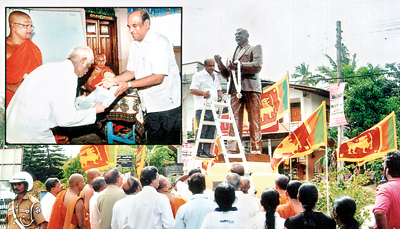HabuthalaViharaya or Tharulengala Monastery
Few hundred meters away from the Karandahela reservoir in the corner of Hulannuge is the HabuthalaViharaya or Tharulengala  Forest Hermitage. Built before the second century BC by King Kavantissa on a 633 feet tall hillock and developed constantly throughout the Eastern history the monastery is home to some of the largest drip ledged caves in the country.
Forest Hermitage. Built before the second century BC by King Kavantissa on a 633 feet tall hillock and developed constantly throughout the Eastern history the monastery is home to some of the largest drip ledged caves in the country.
This 512ft long drip ledged cave is 30ft broad and 82ft high at the highest point with eight levels in its interior. The signs of brick layered interiors and polished and cemented inner walls still remain within the cave indicating that the cave was utilised for worship or a gathering hall for the monks of the monastery.
 The time and origin of its construction is unknown as there are no inscriptions discovered within the cave so far. Close to this mammoth cave is another 200 ft length, drip ledged and constructed with the same interior finish, believed to have been used as a community quarter than an individual abode.
The time and origin of its construction is unknown as there are no inscriptions discovered within the cave so far. Close to this mammoth cave is another 200 ft length, drip ledged and constructed with the same interior finish, believed to have been used as a community quarter than an individual abode.
The next largest cave in the complex is a cave styled as a shrine room. Situated near the  entrance to the monastery the cave is 175ft long, 31ft broad and 35ft high and houses a 41ft reclining Buddha statue, now considerably damaged by treasure hunters. Once, the plaster and murals adorned the inner walls and ceilings of the cave had given away to the perils of time revealing earlier drawings of the Veddah community, who had called the caves their home prior to the construction of the monastery. The drawings include scenes of hunting, war and animal flocks, suggesting a pre historic life style that was long lost. The entrance to the cave is adorned with a simple rock carved stairway and a “sandakadapahana” or moonstone, that lie in ruins today.
entrance to the monastery the cave is 175ft long, 31ft broad and 35ft high and houses a 41ft reclining Buddha statue, now considerably damaged by treasure hunters. Once, the plaster and murals adorned the inner walls and ceilings of the cave had given away to the perils of time revealing earlier drawings of the Veddah community, who had called the caves their home prior to the construction of the monastery. The drawings include scenes of hunting, war and animal flocks, suggesting a pre historic life style that was long lost. The entrance to the cave is adorned with a simple rock carved stairway and a “sandakadapahana” or moonstone, that lie in ruins today.
At the water’s edge of this Karandewewa tank are the remains of an ancient stupa belonging to the earliest constructions of the  monastery. Two more ruined stupas are found further uphill and believed to have enshrined the remains of the arahants, who had once meditated at the grounds of Habuthala.
monastery. Two more ruined stupas are found further uphill and believed to have enshrined the remains of the arahants, who had once meditated at the grounds of Habuthala.
Scattered among the grounds of Habuthala Viharaya are rock ponds of various size. Created to store water for the use of hundreds of monks who lived and meditated in Habuthala viharaya, these ponds are the playgrounds and abodes of wild leopards and bears that inhabit most of the monastery’s caves today.
Source: Sri Lanka Tourism Development Authority
http://www.srilanka.travel/lesserknown
Follow @timesonlinelk
comments powered by Disqus
























